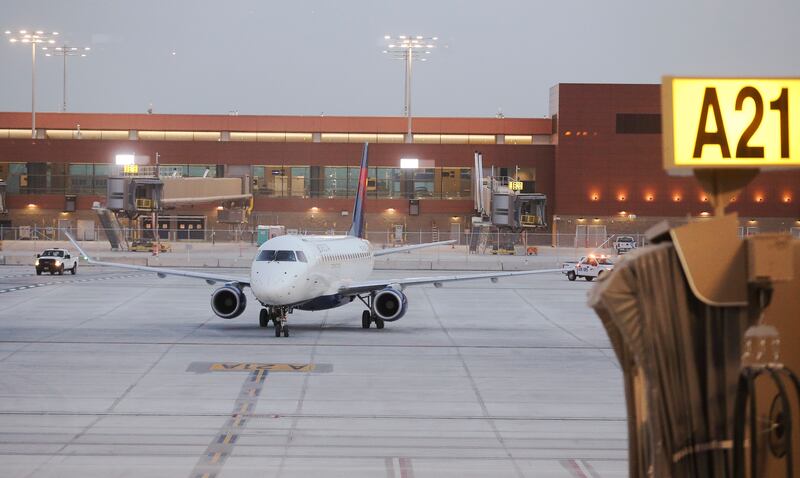As I write, I’m seated on the outdoor observation deck at San Francisco International Airport. I’m waiting for a flight to Sydney, Australia, where I will be researching how flight patterns between Australia and Europe with an intermediate stop, something known as the “Kangaroo Route,” helped integrate Australia into the Asian economy. Many times, passengers stopping in places like Singapore decide to return for a vacation to the city where they had a stopover on the way to Europe.
Now that the new Salt Lake City International Airport has been operational for two years, it’s fair to ask if the airport will be able to achieve “the stopover effect.” I’ve adapted this term from my own research on the evolution of how airports spur tourism as well as the work of aviation specialists on how passengers select connecting cities and make layover cities into tourist destinations in their own right.
“The stopover effect” happens when a passenger in transit has such a favorable experience in a connecting airport that he or she chooses to return to the city as a destination in its own right.
Despite persistent complaints about the distance passengers must walk between concourses at the new airport, among other critiques, it still may be too early to render a final verdict on the new airport’s form and function until the second phase is completed in 2024.
What would convert a transit passenger into a Salt Lake City tourist just by making a connection at the airport?
While some factors are now fixed (such as the orientation of the concourses), there are adaptations that might provide a more pleasurable experience for passengers. Some factors might include greater attention to families traveling with children and a cultural experience associated with Salt Lake’s historical identity.
Frankly, Salt Lake City should be known as one of the most family-friendly airports in the world, given the Utah’s high per capita rate of natural increase, youthful population and cultural association with robust families. The airport has won praise for its elegant lines, particularly at the nexus where passport control intersects with concourse A, also known as “Terminal Plaza.”
The wide observation deck there is a nice touch, where families are often found, their children with little to do while waiting for their flight. The grand piano is classy but offers limited opportunity for use among the throngs transiting the space. This is the one area that could be transformed into a children’s play area, conceivably called “the Valley” — to continue the architectural metaphor that extends from “the canyons” above the exit control, stretching into baggage claim.
Given the incidence of “trampoline parks” and children’s play places throughout Utah, some variety of activities — perhaps including modest rope ladders arranged around a foam or ball pit — would brighten Terminal Plaza, which will be extended to include more shops when Concourse A is extended to its final length of 3,700 feet by the end of 2024.
To add to the family-friendly approach, a sweet spot in dining options needs to be considered. Images come to mind of long lines snaking out of the McDonalds in the old Salt Lake Airport. The current airport features what might be considered “premium price” dining options as well as the outlet of a convenience store, but little in the way of modestly priced fast food that was in abundance in the former airport. A family-friendly airport has a place to buy an inexpensive fountain soft drink, a small pack of fries, or a soft serve ice cream cone to keep an overwrought child happy until the next flight.
Finally, a memorable cultural experience might help lure passengers back to Salt Lake City for a two-to-three-day vacation. Skiing sells itself, as do the state’s supernal national parks. Other airports in the region, however, have marketed their airports based on the airport itself or a cultural offering housed there.
Denver International Airport has embraced its conspiratorial history (of cost overruns and what might exist in the underground tunnels) and made it a selling part of the airport. San Francisco International Airport boasts a library dedicated to commercial aviation, located inside and open to anyone interested in flight.
If money were not an issue, it would be both an educational experience and a reflection of Utah’s heritage to have Ancestry.com or FamilySearch locate a highly interactive public or private space in one of the concourses, featuring an array of opportunities for passengers to learn basic aspects about their individual family history — with an invitation to return at a later date, with Salt Lake City as a destination for further research.
While there have been many criticisms of the new airport, there are ample opportunities to help the airport grow as a part of the community, which will also contribute to the economic and cultural well-being of the state.
Evan Ward is associate professor of history at Brigham Young University, where he teaches courses on world history and researches the history of travel and tourism, with an emphasis on commercial aviation. He welcomes continued dialogue about the new airport at evan_ward@byu.edu.

